实验5
实验1
代码
#include <stdio.h>
#include<stdlib.h>
#define N 4
int main()
{
int x[N] = {1, 9, 8, 4};
int i;
int *p;
// 方式1:通过数组名和下标遍历输出数组元素
for (i = 0; i < N; ++i)
printf("%d", x[i]);
printf("\n");
// 方式2:通过指针变量遍历输出数组元素 (写法1)
for (p = x; p < x + N; ++p)
printf("%d", *p);
printf("\n");
// 方式2:通过指针变量遍历输出数组元素(写法2)
p = x;
for (i = 0; i < N; ++i)
printf("%d", *(p + i));
printf("\n");
// 方式2:通过指针变量遍历输出数组元素(写法3)
p = x;
for (i = 0; i < N; ++i)
printf("%d", p[i]);
printf("\n");
system("pause");
return 0;
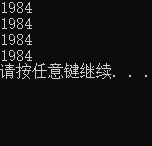
#include <stdio.h>
#include <stdlib.h>
int main()
{
int x[2][4] = {{1, 9, 8, 4}, {2, 0, 4, 9}};
int i, j;
int *p; // 指针变量,存放int类型数据的地址
int(*q)[4]; // 指针变量,指向包含4个int型元素的一维数组
// 使用数组名、下标访问二维数组元素
for (i = 0; i < 2; ++i)
{
for (j = 0; j < 4; ++j)
printf("%d", x[i][j]);
printf("\n");
}
for (p = &x[0][0], i = 0; p < &x[0][0] + 8; ++p, ++i)
{
printf("%d", *p);
if ((i + 1) % 4 == 0)
printf("\n");
}
for (q = x; q < x + 2; ++q)
{
for (j = 0; j < 4; ++j)
printf("%d", *(*q + j));
printf("\n");
}
system("pause");
return 0;
}

实验2
#include <stdio.h>
#include <string.h>
#define N 80
int main()
{
char s1[] = "Learning makes me happy";
char s2[] = "Learning makes me sleepy";
char tmp[N];
printf("sizeof(s1) vs. strlen(s1): \n");
printf("sizeof(s1) = %d\n", sizeof(s1));
printf("strlen(s1) = %d\n", strlen(s1));
printf("\nbefore swap: \n");
printf("s1: %s\n", s1);
printf("s2: %s\n", s2);
printf("\nswapping...\n");
strcpy(tmp, s1);
strcpy(s1, s2);
strcpy(s2, tmp);
printf("\nafter swap: \n");
printf("s1: %s\n", s1);
printf("s2: %s\n", s2);
return 0;
}
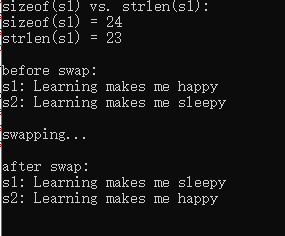
字节,字符串长度,不能,没有长度说明
#include <stdio.h>
#include <string.h>
#include<stdlib.h>
#define N 80
int main()
{
char *s1 = "Learning makes me happy";
char *s2 = "Learning makes me sleepy";
char *tmp;
printf("sizeof(s1) vs. strlen(s1): \n");
printf("sizeof(s1) = %d\n", sizeof(s1));
printf("strlen(s1) = %d\n", strlen(s1));
printf("\nbefore swap: \n");
printf("s1: %s\n", s1);
printf("s2: %s\n", s2);
printf("\nswapping...\n");
tmp = s1;
s1 = s2;
s2 = tmp;
printf("\nafter swap: \n");
printf("s1: %s\n", s1);
printf("s2: %s\n", s2);
system("pause");
return 0;
}
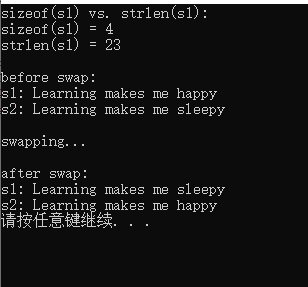
存放地址,sizeof是指针的字节,字符串长度,可以
实验3
#include <stdio.h>
#include<stdlib.h>
void str_cpy(char *target, const char *source);
void str_cat(char *str1, char *str2);
int main()
{
char s1[80], s2[20] = "1984";
str_cpy(s1, s2);
puts(s1);
str_cat(s1, " Animal Farm");
puts(s1);
system ("pause");
return 0;
}
void str_cpy(char *target, const char *source)
{
while (*target++ = *source++)
;
}
void str_cat(char *str1, char *str2)
{
while (*str1)
str1++;
while (*str1++ = *str2++);
}
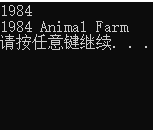
实验5
#include <stdio.h>
#include<stdlib.h>
#define N 80
int func(char *);
int main()
{
char str[80];
while (gets(str) != NULL)
{
if (func(str))
printf("yes\n");
else
printf("no\n");
}
system("pause");
return 0;
}
int func(char *str)
{
char *begin, *end;
begin = end = str;
while (*end)
end++;
end--;
while (begin < end)
{
if (*begin != *end)
return 0;
else
{begin++;
end--;}
}
return 1;
}

#include <stdio.h>
#define N 80
void func(char *);
int main()
{
char s[N];
while (scanf("%s", s) != EOF)
{
func(s);
puts(s);
}
return 0;
}
void func(char *str)
{
int i;
char *p1, *p2, *p;
p1 = str;
while (*p1 == '*')
p1++;
p2 = str;
while (*p2)
p2++;
p2--;
while (*p2 == '*')
p2--;
p = str;
i = 0;
while (p < p1)
{
str[i] = *p;
p++;
i++;
}
while (p <= p2)
{
if (*p != '*')
{
str[i] = *p;
i++;
} p
++;
}
while (*p != '\0')
{
str[i] = *p;
p++;
i++;
} str[i] = '\0';
}

实验6
#include <stdio.h>
#include <string.h>
#include<stdlib.h>
void sort(char *name[], int n);
int main()
{
char *course[4] = {"C Program",
"C++ Object Oriented Program",
"Operating System",
"Data Structure and Algorithms"};
int i;
sort(course, 4);
for (i = 0; i < 4; i++)
printf("%s\n", course[i]);
system("pause");
return 0;
}
void sort(char *name[], int n)
{
int i, j;
char *tmp;
for (i = 0; i < n - 1; ++i)
for (j = 0; j < n - 1 - i; ++j)
if (strcmp(name[j], name[j + 1]) > 0)
{
tmp = name[j];
name[j] = name[j + 1];
name[j + 1] = tmp;
}
}
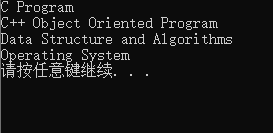
#include <stdio.h>
#include <string.h>
#include<stdlib.h>
void sort(char *name[], int n);
int main()
{
char *course[4] = {"C Program",
"C++ Object Oriented Program",
"Operating System",
"Data Structure and Algorithms"};
int i;
sort(course, 4);
for (i = 0; i < 4; i++)
printf("%s\n", course[i]);
system("pause");
return 0;
}
void sort(char *name[], int n)
{
int i, j, k;
char *tmp;
for (i = 0; i < n - 1; i++)
{
k = i;
for (j = i + 1; j < n; j++)
if (strcmp(name[j], name[k]) < 0)
k = j;
if (k != i)
{
tmp = name[i];
name[i] = name[k];
name[k] = tmp;
}
}
}
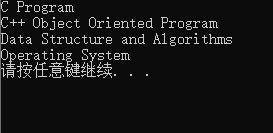
交换指针变量的值
实验7
#include <stdio.h>
#include <string.h>
#include<stdlib.h>
#define N 5
int check_id(char *str); // 函数声明
int main()
{
char *pid[N] = {"31010120000721656X",
"330106199609203301",
"53010220051126571",
"510104199211197977",
"53010220051126133Y"};
int i;
for (i = 0; i < N; ++i)
if (check_id(pid[i])) // 函数调用
printf("%s\tTrue\n", pid[i]);
else
printf("%s\tFalse\n", pid[i]);
system("pause");
return 0;
}
// 函数定义
// 功能: 检查指针str指向的身份证号码串形式上是否合法。
// 形式合法,返回1,否则,返回0
int check_id(char *str)
{
int i,j=1;
if(strlen(str)!=18)
j=0;
for(i=0;str[i]!='\0';i++)
{
if(str[i]>='A'&&str[i]<='Z'&&str[i]!='X')
j=0;
}
return j;
}
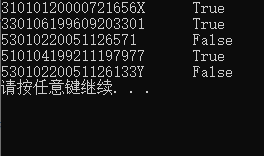
实验8
#include <stdio.h>
#define N 80
void encoder(char *s); // 函数声明
void decoder(char *s); // 函数声明
int main()
{
char words[N];
printf("输入英文文本: ");
gets(words);
printf("编码后的英文文本: ");
encoder(words); // 函数调用
printf("%s\n", words);
printf("对编码后的英文文本解码: ");
decoder(words); // 函数调用
printf("%s\n", words);
return 0;
}
/*函数定义
功能:对s指向的字符串进行编码处理
编码规则:
对于a~z或A~Z之间的字母字符,用其后的字符替换; 其中,z用a替换,Z用A替换
其它非字母字符,保持不变
*/
void encoder(char *s)
{
int i,j;
for(i=0;s[i]!='\0';i++)
{
if(s[i]>='a'&&s[i]<'z')
s[i]=s[i]+1;
else if(s[i]=='z')
s[i]='a';
if(s[i]>='A'&&s[i]<'Z')
s[i]=s[i]+1;
else if(s[i]=='Z')
s[i]='A';
}
}
/*函数定义
功能:对s指向的字符串进行解码处理
解码规则:
对于a~z或A~Z之间的字母字符,用其前面的字符替换; 其中,a用z替换,A用Z替换
其它非字母字符,保持不变
*/
void decoder(char *s)
{
int i,j;
for(i=0;s[i]!='\0';i++)
{
if(s[i]>'a'&&s[i]<='z')
s[i]=s[i]-1;
else if(s[i]=='a')
s[i]='z';
if(s[i]>'A'&&s[i]<='Z')
s[i]=s[i]-1;
else if(s[i]=='A')
s[i]='Z';
}
}
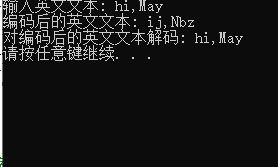
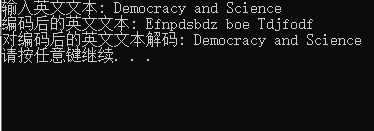




 浙公网安备 33010602011771号
浙公网安备 33010602011771号